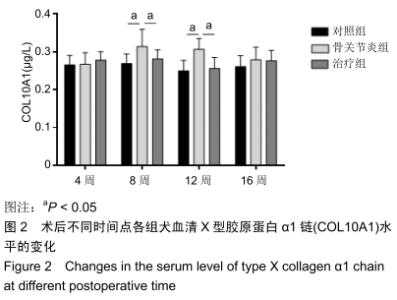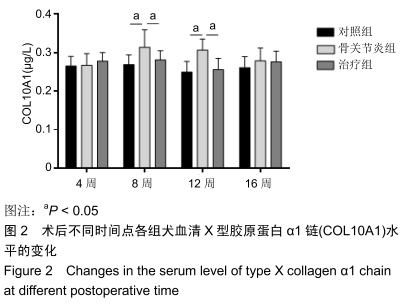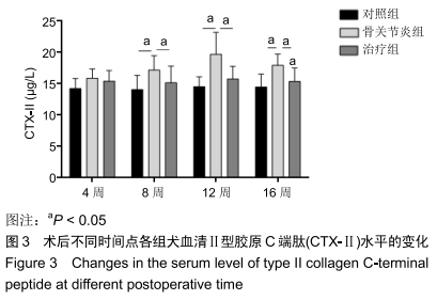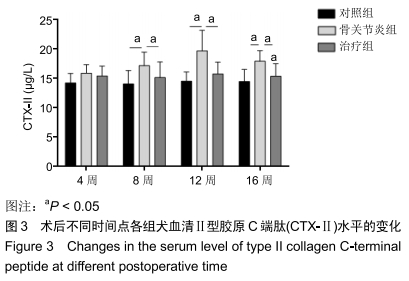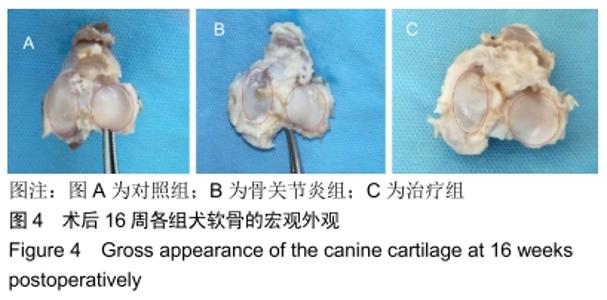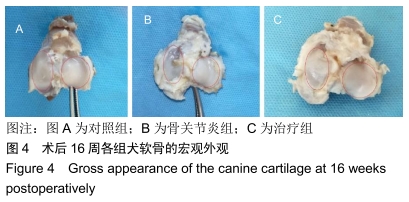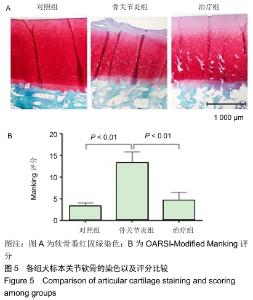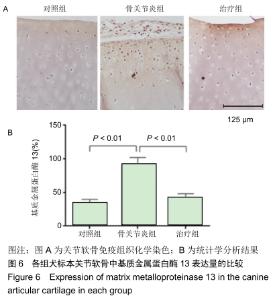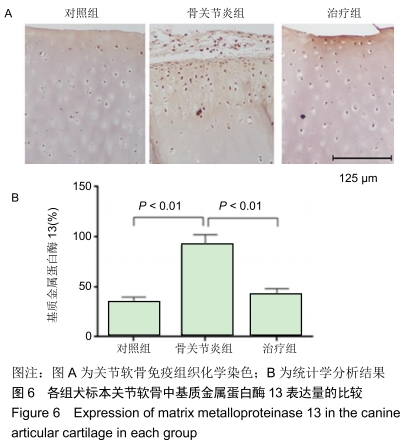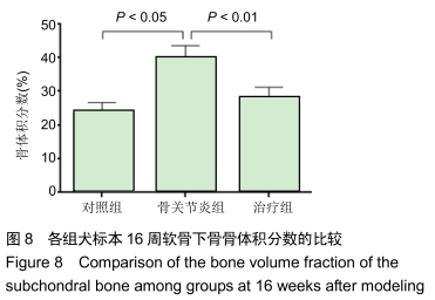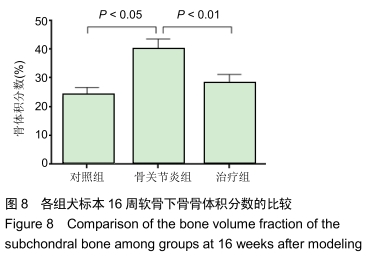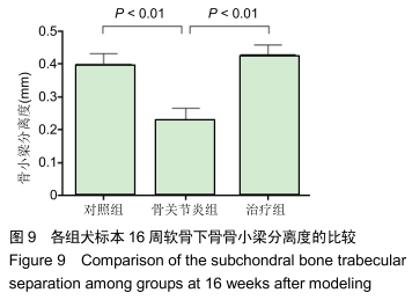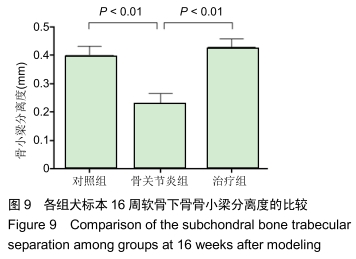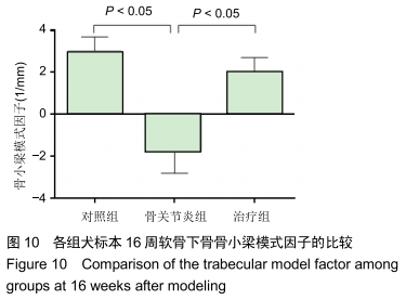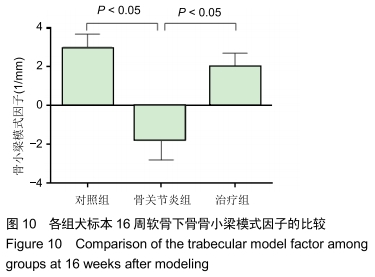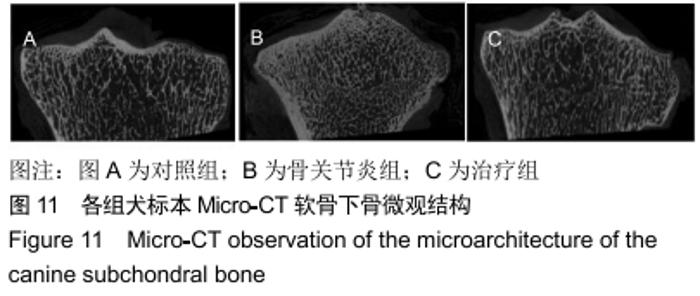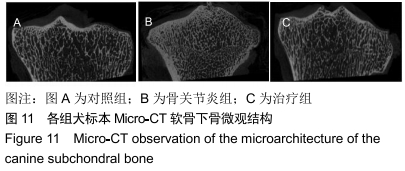Chinese Journal of Tissue Engineering Research ›› 2020, Vol. 24 ›› Issue (14): 2147-2152.doi: 10.3969/j.issn.2095-4344.2539
Previous Articles Next Articles
Local injection of halofuginone into the subchondral bone relieves canine osteoarthritis by inhibiting transforming growth factor beta 1 signaling pathway
Ren Jiangdong1, Shalitanati • Wuermanbieke1, Nuerailijiang • Yushan1, Wuhuzi • Wulamu1, Cao Li2
- 1Department of Joint Surgery, 2Center of Orthopedics, First Affiliated Hospital of Xinjiang Medical University, Urumqi 830054, Xinjiang Uygur Autonomous Region, China
-
Received:2019-06-11Revised:2019-06-13Accepted:2019-08-09Online:2020-05-18Published:2020-03-13 -
Contact:Cao Li, Chief physician, Professor, Center of Orthopedics, First Affiliated Hospital of Xinjiang Medical University, Urumqi 830054, Xinjiang Uygur Autonomous Region, China -
About author:Ren Jiangdong, MD, Associate chief physician, Department of Joint Surgery, First Affiliated Hospital of Xinjiang Medical University, Urumqi 830054, Xinjiang Uygur Autonomous Region, China -
Supported by:the National Natural Science Foundation of China, No. U1503221
CLC Number:
Cite this article
Ren Jiangdong, Shalitanati • Wuermanbieke, Nuerailijiang • Yushan, Wuhuzi • Wulamu, Cao Li. Local injection of halofuginone into the subchondral bone relieves canine osteoarthritis by inhibiting transforming growth factor beta 1 signaling pathway[J]. Chinese Journal of Tissue Engineering Research, 2020, 24(14): 2147-2152.
share this article
| [1] MCALINDON TE, BANNURU RR, SULLIVAN MC,et al. OARSI guidelines for the non-surgical management of knee osteoarthritis. Osteoarthr Cartil.2014;22:363-388. [2] TANG X, WANG S, ZHAN S,et al. The prevalence of symptomatic knee osteoarthritis in China: Results from China Health and Retirement Longitudinal Study.Arthritis Rheumatol. 2016;68(3): 648-653. [3] LEE S, KIM SJ.Prevalence of knee osteoarthritis, risk factors, and quality of life: The Fifth Korean National Health And Nutrition Examination Survey.Int J Rheum Dis. 2017;20(7):809-817. [4] ELKIN M, ARIEL I, MIAO HQ, et al.Inhibition of bladder carcinoma angiogenesis, stromal support, and tumor growth by halofuginone. Cancer Res.1999;59(16): 4111-4118. [5] YEE KO, CONNOLLY CM, PINES M, et al,Halofuginone inhibitstumor growth in the polyoma middle T antigen mouse via athrombospondin-1 independent mechanism.Cancer Biol Ther.2006;5(2):218-224. [6] GNAINSKY Y, KUSHNIRSKY Z, BILU G, et al. Gene expression during chemically induced liver fibrosis: effect of halofuginone on TGF-βsignaling.Cell Tissue Res.2007;328(1):153-166. [7] TURGEMAN T, HAGAI Y, HUEBNER K, et al.Prevention of muscle fibrosis and improvement in muscle performance in the mdx mouse by halofuginone.Neuromuscul Disord.2008;18(11): 857-868. [8] JI B, ZHANG Z, GUO W, et al. Isoliquiritigenin blunts osteoarthritis by inhibition of bone resorption and angiogenesis in subchondral bone. Scientific Reports.2018;8(1):1721. [9] CUI Z, CRANE J, XIE H, et al. Halofuginone attenuates osteoarthritis by inhibition of TGF- activity and H-type vessel formation in subchondral bone. Ann Rheum Dis. 2016;75(9):1714-1721. [10] TANG Y, WU X, LEI W, et al. TGF-β1–induced migration of bone mesenchymal stem cells couples bone resorption with formation.Nat Med.2009;15(7):757-765. [11] WENBO M, BOYONG X, HAIRONG M, et al.Halofuginone Attenuates Osteoarthritis by Rescuing Bone Remodeling in Subchondral Bone Through Oral Gavage.Front Pharmacol. 2018;9:269. [12] LOESER RF, GOLDRING SR, SCANZELLO CR, et al.Osteoarthritis: a disease of the joint as an organ. Arthritis Rheum.2012; 64:1697-1707. [13] LOESER RF, COLLINS JA, DIEKMAN BO.Ageing and the pathogenesis of osteoarthritis.Nat Rev Rheumatol.2016;12(7):412-420. [14] EDITH C, BISERKA R, DEROYER CÉLINE, et al.Insights on Molecular Mechanisms of Chondrocytes Death in Osteoarthritis.Int J Mol Sci. 2016;17(12). pii: E2146. [15] CHEN D, SHEN J, ZHAO W, et al. Osteoarthritis: toward a comprehensive understanding of pathological mechanism.Bone Res. 2017;5:16044. [16] LOESER RF. Aging and osteoarthritis: the role of chondrocyte senescence and aging changes in the cartilage matrix.Osteoarthritis Cartilage. 2009;17(8):971-979. [17] FANG J, XU L, LI Y, et al. Roles of TGF-beta 1 signaling in the development of osteoarthritis.Histol Histopathol. 2016;31(11): 1161-1167. [18] ZHU M, TANG D, WU Q, et al.Activation of β-catenin signaling in articular chondrocytes leads to osteoarthritis-like phenotype in adult β-catenin conditional activation mice. Bone Miner Res.2009; 24(1): 12-21. [19] LIN AC, SEETO BL, BARTOSZKO JM, et al.Modulating hedgehog signaling can attenuate the severity of osteoarthritis.Nat Med. 2009; 15:1421-1425. [20] SAITO T, FUKAI A, MABUCHI A, et al.Transcriptional regulation of endochondral ossification by HIF-2α during skeletal growth and osteoarthritis development.Nat Med.2010;16(6):678-686. [21] YANG S, KIM J, RYU JH, et al.Hypoxia-inducible factor-2alpha is a catabolic regulator of osteoarthritic cartilage destruction.Nat Med. 2011;16(6):687. [22] GOLDRING SR, GOLDRING MB.Changes in the osteochondral unit during osteoarthritis: structure, function and cartilage-bone crosstalk. Nat Rev Rheumatol. 2016;12(11):632-644. [23] ROBINSON WH, LEPUS CM, WANG Q, et al. Low-grade inflammation as a key mediator of the pathogenesis of osteoarthritis.Nat Rev Rheumatol. 2016;12(10):580-592. [24] BURR DB, GALLANT MA. Bone remodelling in osteoarthritis.Nat Rev Rheumatol. 2012;8(11):665-673. [25] Cao X.Targeting osteoclast-osteoblast communication.Nat Med.2011; 17(11):1344-1346. [26] BURR DB, RADIN EL.Microfractures and microcracks in subchondral bone: are they relevant to osteoarthrosis?.Rheum Dis Clin North Am . 2003;29(4):675-685. [27] SNIEKERS YH, INTEMA F, LAFEBER FP, et al. A role for subchondral bone changes in the process of osteoarthritis; a micro-CT study of two canine models.BMC Musculoskelet Disord. 2008;9:20. [28] XIE L, TINTANI F, WANG X, et al. Systemic neutralization of TGF-β attenuates osteoarthritis. Ann N Y Acad Sci. 2016;1376(1):53-64. [29] CASTAÑEDA S, ROMAN-BLAS JA, LARGO R,et al. Subchondral bone as a key target for osteoarthritis treatment.Biochem Pharmacol. 2012;83(3):315-323. [30] SURI S, DAVID A. Walsh. Osteochondral alterations in osteoarthritis. Bone.2012;51(2):204-211. [31] CHRISTGAU S, GARNERO P, FLEDELIUS C, et al. Collagen type IIC-telopeptide fragments as an index of cartilage degradation. Bone. 2001;29(3):209-215. [32] LUYTEN FP, LORIES RJU, VERSCHUEREN P, et al. Contemporary concepts of inflammation, damage and repair in rheumatic diseases.Best Pract Res Clin Rheumatol. 2006;20(5):829-848. [33] GOLDRING MB, GOLDRING SR.Articular cartilage and subchondral bone in the pathogenesis of osteoarthritis.Ann N Y Acad Sci. 2010; 1192:230-237. [34] VON D MK, KIRSCH T, NERLICH A, et al.Type X collagen synthesis in human osteoarthritic cartilage. Indication of chondrocyte hypertrophy. Arthritis Rheum.2010;35(7):806-811. |
| [1] | Peng Zhihao, Feng Zongquan, Zou Yonggen, Niu Guoqing, Wu Feng. Relationship of lower limb force line and the progression of lateral compartment arthritis after unicompartmental knee arthroplasty with mobile bearing [J]. Chinese Journal of Tissue Engineering Research, 2021, 25(9): 1368-1374. |
| [2] | Huang Dengcheng, Wang Zhike, Cao Xuewei. Comparison of the short-term efficacy of extracorporeal shock wave therapy for middle-aged and elderly knee osteoarthritis: a meta-analysis [J]. Chinese Journal of Tissue Engineering Research, 2021, 25(9): 1471-1476. |
| [3] | Liu Xiangxiang, Huang Yunmei, Chen Wenlie, Lin Ruhui, Lu Xiaodong, Li Zuanfang, Xu Yaye, Huang Meiya, Li Xihai. Ultrastructural changes of the white zone cells of the meniscus in a rat model of early osteoarthritis [J]. Chinese Journal of Tissue Engineering Research, 2021, 25(8): 1237-1242. |
| [4] | Liu Xin, Yan Feihua, Hong Kunhao. Delaying cartilage degeneration by regulating the expression of aquaporins in rats with knee osteoarthritis [J]. Chinese Journal of Tissue Engineering Research, 2021, 25(5): 668-673. |
| [5] | Ma Zetao, Zeng Hui, Wang Deli, Weng Jian, Feng Song. MicroRNA-138-5p regulates chondrocyte proliferation and autophagy [J]. Chinese Journal of Tissue Engineering Research, 2021, 25(5): 674-678. |
| [6] | Cao Xuhan, Bai Zixing, Sun Chengyi, Yang Yanjun, Sun Weidong. Mechanism of “Ruxiang-Moyao” herbal pair in the treatment of knee osteoarthritis based on network pharmacology [J]. Chinese Journal of Tissue Engineering Research, 2021, 25(5): 746-753. |
| [7] | Li Yonghua, Feng Qiang, Tan Renting, Huang Shifu, Qiu Jinlong, Yin Heng. Molecular mechanism of Eucommia ulmoides active ingredients treating synovitis of knee osteoarthritis: an analysis based on network pharmacology [J]. Chinese Journal of Tissue Engineering Research, 2021, 25(5): 765-771. |
| [8] | Song Shan, Hu Fangyuan, Qiao Jun, Wang Jia, Zhang Shengxiao, Li Xiaofeng. An insight into biomarkers of osteoarthritis synovium based on bioinformatics [J]. Chinese Journal of Tissue Engineering Research, 2021, 25(5): 785-790. |
| [9] | Deng Zhenhan, Huang Yong, Xiao Lulu, Chen Yulin, Zhu Weimin, Lu Wei, Wang Daping. Role and application of bone morphogenetic proteins in articular cartilage regeneration [J]. Chinese Journal of Tissue Engineering Research, 2021, 25(5): 798-806. |
| [10] | Zheng Li, Li Dadi, Hu Weifan, Tang Jinlong, Zhao Fengchao. Risk assessment of contralateral knee arthroplasty after unilateral total knee arthroplasty [J]. Chinese Journal of Tissue Engineering Research, 2021, 25(3): 374-379. |
| [11] | Lü Jiaxing, Bai Leipeng, Yang Zhaoxin, Miao Yuesong, Jin Yu, Li Zhehong, Sun Guangpu, Xu Ying, Zhang Qingzhu. Evaluation of internal fixation with proximal femoral nail antirotation in elderly knee osteoarthritis patients with femoral intertrochanteric fractures [J]. Chinese Journal of Tissue Engineering Research, 2021, 25(3): 391-396. |
| [12] | Luo Anyu, Liu Hanlin, Xie Xiaofei, Huang Chen. Effect of antioxidant mixture on structural degeneration of an osteoarthritis rat model [J]. Chinese Journal of Tissue Engineering Research, 2021, 25(23): 3625-3629. |
| [13] | Gao Kun, Chen Dayu, Zhang Yong, Liu Weidong, Sun Shufen, Lai Wenqiang, Ma Dujun, Wu Yihong, Lin Zhanpeng, Jiang Yinglu, Yu Weiji. Achyranthes bidentata alcohol extract inhibits extracellular matrix degradation of the cartilage by regulating synovial fibroblast exosomes [J]. Chinese Journal of Tissue Engineering Research, 2021, 25(23): 3636-3640. |
| [14] | Liu Jinfu, Zeng Ping, Nong Jiao, Fan Siqi, Feng Chengqin, Huang Jiaxing. Integrative analysis of biomarkers and therapeutic targets in synovium of patients with osteoarthritis by multiple microarrays [J]. Chinese Journal of Tissue Engineering Research, 2021, 25(23): 3690-3696. |
| [15] | Chen Feng, Zhang Xiaoyun, Chen Yueping, Liao Jianzhao, Li Jiajun, Song Shilei, Lai Yu. Molecular mechanism of anhydroicaritin in the treatment of osteoarthritis: an analysis based on network pharmacology and bioinformatics [J]. Chinese Journal of Tissue Engineering Research, 2021, 25(23): 3704-3710. |
| Viewed | ||||||
|
Full text |
|
|||||
|
Abstract |
|
|||||
